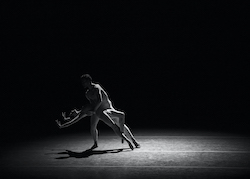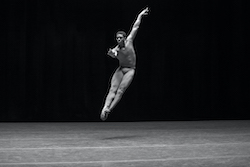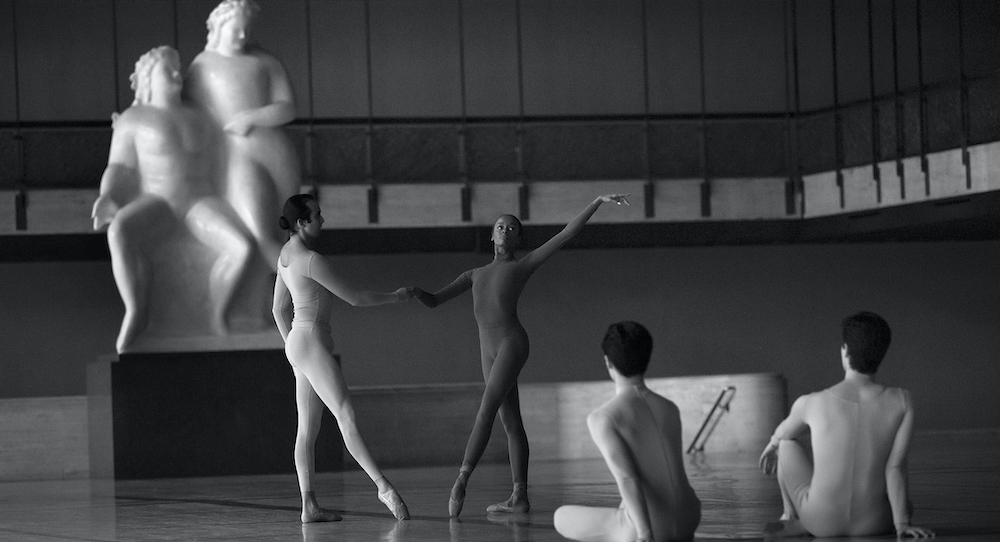April 8, 2021.
On YouTube, as part of New York City Ballet’s digital season.
In the quiet of solitude, with all of the noise of the busy world stripped away, we can get back to essence — the essence of who we are, what we want, what we don’t want, what we believe, what we don’t believe and more. In the relative quiet of COVID, absent the typical hustle and bustle of 21st century life, many people have had that quiet of solitude.
In a bubble residency at Kaatsbaan Cultural Park (Tivoli, NY), Kyle Abraham set a work on eight New York City Ballet dancers — resulting in When We Fell, an abstract and poignant work underscoring this theme of getting back to an underlying essence. Abraham and cinematographer Ryan Marie Helfant co-directed the film, with editing from Esteban Pedraza. As Artistic Director Wendy Whelan notes in an introduction to the work, it’s the most “ambitious” creation of a new work that the company has attempted since the onset of COVID. It’s Abraham’s third work set on the company, and an understanding of how to bring out the best in dancers who excel in Balanchine style is indeed evident in it.

A black and white aesthetic sets a somber, reflective tone from the work’s start. One, and then two dancers move — together and apart — in a spare, open and otherwise empty concert hall lobby. There’s a quiet at hand, even as the easy adagio music accompanies the dancers (score by Morton Feldman, Jason Moran and Nico Muhly). Aligning with that austere feel, the dancers wear unitards in one solid color (costume consulting from Marc Happel). The movement, also in alignment with the overall aesthetic, has a striking simplicity and sustainment — although dancers add layers of complexity and nuance through the sustainment.
Arabesques melt into pirouettes, tendus move forward and back with the hips thrust in the opposing direction or kept placed. Partnering, with a certain spatial distance between the bodies partnering, has clear architectural structure. This movement vocabulary brings a sense of going “back to basics”; what is there when we strip away all of the noise, all of the action and excess? That’s a question we’ve certainly come to ask through this past year as our lives changed in unimaginable ways. Additional dancers join until there is a group of five, a slow adding on to an essence.
A notable shift comes as the structure returns to the dancing of a soloist. His movement is more serpentine, less strictly geometric in quality than seen in the work thus far — with curves through the spine, arches and contractions. Gestures through those sinuous arm movements reshape the fundamental ballet vocabulary at the root of the movement. Soon comes abruptly-shifting images of patterned, sequential objects, all in a close-up view — the material of an iron fence, cracks in ice and (it can make the heart race and the skin crawl to see) what looks like packaged bullets.
This abstraction feels mysterious at first, seemingly with an aesthetic intent or an intent to elicit an emotional response. Yet, one could connect it to that idea of zooming in on something’s essence, what really lies within it and makes it what it is.
We see that same soloist again, on a bare stage. Again an accumulation of dancers occurs, this time moving in that more curvilinear fashion of spinal undulation and release. This brings to mind for me cycles — yet within those cycles returning not to the same thing but a variation on what was before. That offers the possibility to keep what serves and leave behind what doesn’t.
A pas de deux toward the end offers another kind of paring back to an essence — to two people together in space, to the energetic dynamics and the way their bodies move together in space. The light and shadow on their two dancing bodies, illuminating and darkening their long lines and spinal curves — the simplicity and clarity of the aesthetic is just about breathtaking.
The dancers leave the stage, and the lights slowly dim down (lighting design by Dan Scully), taking time for the energy to dissipate and for the fading light and changing shadows to have its own beauty. The camera slowly pans back from there, revealing a large chandelier and small lights around it dimly lighting the surrounding space — the chandelier in NYCB’s home theater, the Edward H. Koch theater. With this image, I think about perspective; how one observes an object, an idea or an image can change its meaning for them.

The work’s opening of snow, waves in the background coming into focus, as well as different camera views throughout the work (directly in front, panned backward, overhead or from a side diagonal) lays a foundation for that idea of perspective. One could argue that idea connects to the idea of stripping something down to its essence; before we judge or evaluate what we see, what perspective we’re seeing from might very well be a vital question of self-inquiry.
A documentary short about the making of the work airs after the presentation of the work itself. It adds further context for understanding the work, perhaps changing the perspective from which audience members see it. For example, Abraham explains how he let the natural setting at Kaatsbaan influence him creatively — hence, the opening of shots of snow, the relative quiet and white/grey aesthetic.
In solo interviews, interspersed with rehearsal footage, the dancers share some of the struggles of coming back to dancing at peak performance quality after dancing in their home or taking time off from dance, why they nevertheless treasured the process of creating the work with Abraham, why they love what they do, and their hopes for how ballet and dance more broadly will move forward from here. Abraham, ever eloquent about art and the creative process, affirms his belief that creating art requires digging inside of yourself and revealing — with honesty and care — what you find there.
Just as the documentary shares deeper understanding of how the work came to be, all of this sharing has potential to educate the general public on what it’s like to create and live the life of an artist. Getting down to essence in these ways can make us think, re-evaluate and move forward in a new way, and that can make all the difference. Thank you to Abraham and NYCB for shining a light on these important truths — a light allowing us to see them in our own ways, from our own perspectives. That’s another part of art’s essence, and I wouldn’t have it any other way.
By Kathryn Boland of Dance Informa.















